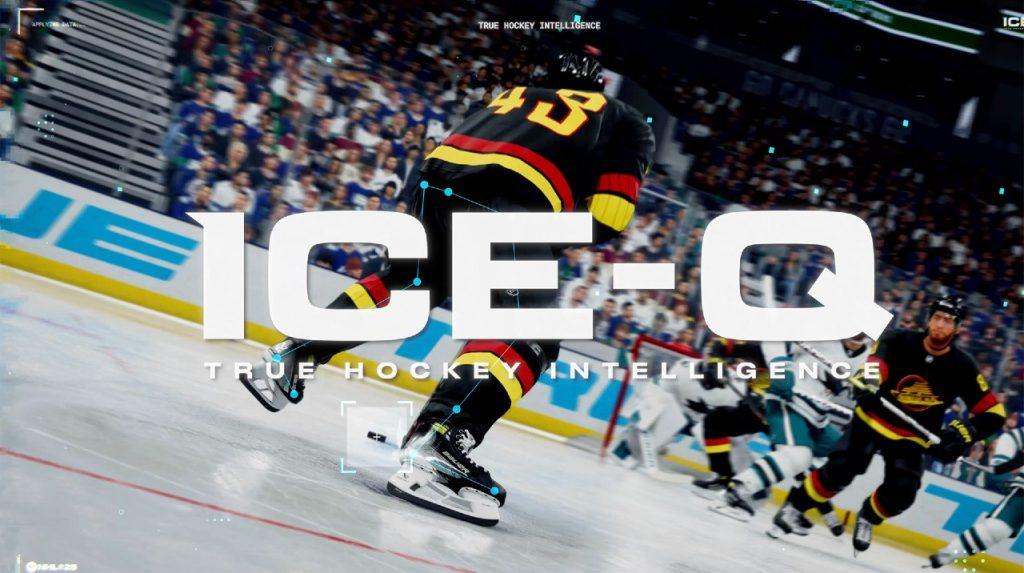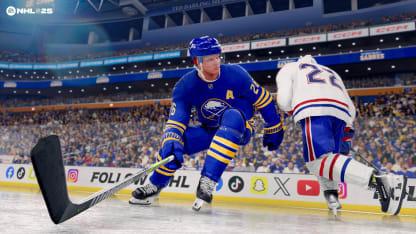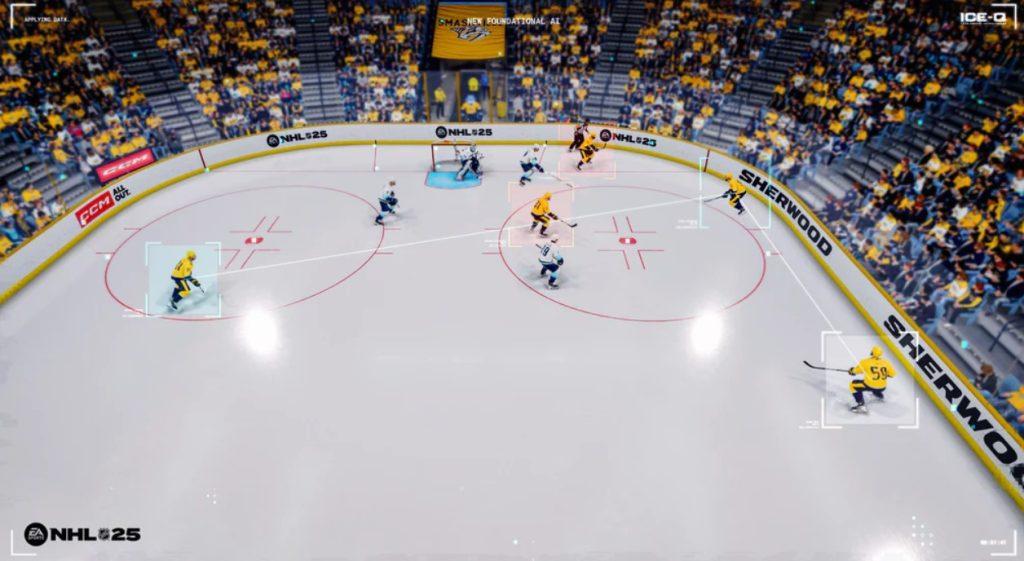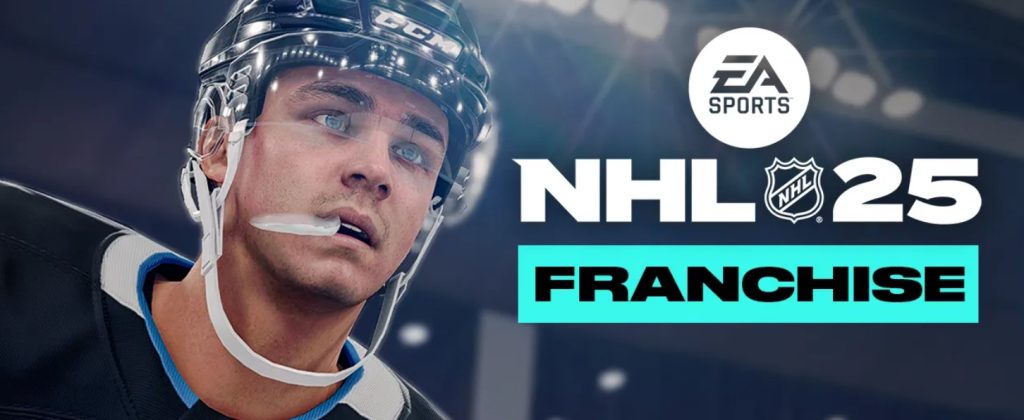NHL25 takes a few strides in the right direction for the franchise by utilizing new AI enhanced features, but it also takes a few steps backwards in terms of presentation. In terms of gameplay the game puts a spin on things by slowing everything down, and fine tuning key mechanics, while closing gaps on previous exploits.
The game enhances specific elements from its predecessors. The implementation of DualSense vibrations for skating remains exceptional, but the addition of pulses during tense moments significantly amplifies the immersion of feeling in the moment. The pressure intensifies when scoring a late goal or defending a lead with high pressure activated, as the controller’s vibrations add an extra layer of tension.
PLATFORM : PS5 / Xbox Series / PC
RELEASE DATE: September 27, 2024
PUBLISHER: EA Sports
GENRE: Sports / Hockey
Certain aspects like this are all heightened to make a sense of panic all the more real, but also makes overcoming these moments all the more rewarding.

ICE-Q Alleviates some of the problems
NHL25 showcases the revolutionary ICE-Q technology, enabling players to adapt and skate with authentic enhancements that lead the franchise in the right direction. This feature enhances puck maneuverability and creates dynamic interactions with opponents, both with and without possession, by allowing you to properly square up to your opponents. While probably not the core intention, the new features also dwindle certain one-off plays prevalent in previous iterations, by making them more challenging to execute. Notably, the once-reliable behind-the-net play, and the synonymous Flying V, have become virtually impossible. Instead the game encourages players to utilize the entire ice surface and retreat towards the blue line for strategic playmaking opportunities.
Considering “walking the blue line” is one of the key features of the new movement system, and it works phenomenally well, I feel the slowed down gameplay and mitigation of chaotic plays was intentional. Elsewhere the team worked on improvements with on-ice plays such as one-timers, and passing, again strengthening the ability to utilize the whole ice properly. An easily missable indicator will light up under an open player that is capable of accepting a one timer, and on ice visual cues assist on potential shots and passing lanes.
However while it’s somewhat nifty, you have to remember this is all happening rather quickly so it’s hard to keep up with so many moving parts. Landing a perfect one timer won’t always lead to a goal, but it’ll at least boost the pressure a bit to give a follow up benefit. And the more experience players have with the system, the easier it will be to develop plays on the fly.
Players not controlled by you also have new features to avoid collisions, but they are also well aware of where other players are and where the puck could potentially move to. So you will see teams properly set up designed plays, and move around the ice to get in positions to assist with creating dynamic plays. They seem to have a good idea of when to leave the zone, or press the net for a better opportunity. It also helps create break out plays where something not entirely designed happens, or a player finds an opportunity, and creates a play that quickly shifts the momentum.
In previous iterations, AI players would basically skate to designated areas, collide with each other, and then hover around their designated spot with no real involvement in the actual play. Collisions were pretty well seen around goalies, or when players were along the benches, and led to some awkward moments. And on-ice awareness was near impossible because the second the opposing team would touch the puck, your entire team was already exiting the zone.
The new AI features actually have them jump in and out of the play, and attempt to find open ice for a pass, or look for rebounds. The defense does a good job of pairing with their man, and closing lanes as well, so you see good movement all around the ice as the AI battles with itself to create these lanes.
In a lot of ways NHL25 improves gameplay in a sense of being overall “smarter” with the puck. The gameplay feels immensely slower than previous generations, which takes some getting use to, but to be honest I hope the refinement comes within specific players, and not an overall increase in gameplay speed like previous titles saw. Some players are painfully slow, I’ll admit, and there isn’t a big enough range between a speed skater and a slower defensemen. But increasing the speed overall is what creates the weak one-off plays we’ve seen before. The slower pacing allows plays to develop, and makes players create on the open ice.
More importantly the drop in speed allows the game to be more fun defensively as well. The slower pace allows poke checks to work properly, and pairing players works well. The game becomes more about positioning and puck movement than it does about body checks and spamming shots. It honestly feels more strategy driven than ever before, and being able to square up with the puck on defense adds a lot of needed improvement.
The major problem with this is that the game still doesn’t have a true training mode yet again, so all your experience comes from in-game moments. This can be frustrating to say the least, so having a training mode to really go in-depth with these mechanics would be highly welcomed.

But it still has problems…..
However certain aspects that were introduced previously are still breaking core mechanics of the game. For example clearing the puck is back to being nearly impossible, especially when a team has built high pressure in your zone. I tried everything from the basic flip out of the zone, to slap shot, and the puck literally dies at the line or finds a way to go directly at a player to keep it in. A few iterations ago the developers actually put in a cool mechanic to clear the puck and I’m not sure why it never returned.
I also felt like utilizing the boards has been nerfed greatly because the puck seems to just die once it hits open ice. A lot of arena’s have really “bouncy” boards in real life, but utilizing them in the game seems like a no-go entirely. Passing between players and setting up plays feels fine, but once the puck is out of someone’s possession it doesn’t fluently go where it needs to go.
The pressure system, for another example, is still very heavily offensive based. Once pressure builds, simple tasks to get the puck back feel disabled and the offensive team feels a lot faster, while avoiding checks and setting up plays. To me this feels like a cheesy handicap that abruptly happens so the AI can catch up or create a tense situation by scoring a goal. The game very much has this sense of “okay they will score now” moments when playing the AI because they enter a god like mode for a few minutes until they do.
And ultimately I’m still a huge fan of the passing system that was developed last year where you can hold the pass button and select the specific player to pass to by utilizing the whole controller buttons. This alone made last year’s game worth buying, but I’m sad that this system wasn’t fully developed this year. I was hoping maybe the new square up system would help lead you to better passing, but it only really helps with shooting since it always squares you to the goal. And beyond that I’m extremely disappointed it didn’t translate to defense still. One of the biggest gripes is that while it’s cool to select your player to pass to, why can’t we have the same option on defense? Simply letting me pick which player I get to on defense would greatly improve gameplay, but we still can’t do that. Instead you’re basically stuck spamming the switch character button until you land on the one you actually want, and oftentimes it picks terribly.

Visually NHL 25 Go Further Backwards
With its broadcast features and visuals, I was a fan of NHL24 in many ways because there were a lot of visual cues introduced that I honestly felt a live broadcast should look to use. Some people, however, were not a fan of NHL 24’s presentation, and I have a feeling they will absolutely hate it this year because of how far reaching it has become.
The game introduces an AI driven broadcast director, which is supposed to create a continuous flow of camera shots, but oftentimes it feels like it’s cutting to random events as the game tries to pre-determine animations and get ahead of it. For example scoring a goal will have 5 different camera angles, and you never really get to absorb the atmosphere it creates. The after goal celebrations don’t feel authentic in the slightest bit at all with how quick they appear and how many times the camera cuts away. Plus the whole arena looks different, and we never get to feel engaged with the audience either.
Which is something else I wish the franchise put more emphasis on. Similar to soccer, hockey is immensely reliant on atmosphere. Every team has perks and crazy fans, but importantly it’s a team sport and usually the entire team is highly involved in the game. NHL 25 doesn’t really engage in much of that. Some teams have a good environment with chants and rowdy fans, but a lot of the smaller markets feel left out. Utah, for example, had absolutely no environment. Again a few iterations ago, the franchise even had obnoxious arena based animations and environments, but all this has been cut out to feel “authentic” and with that it became honestly boring.
What we get is the broadcast cutting to random stale fans with little to no animations, or benches that are not hyped up to be winning a game. We get the same stale animations before and after the game, and little to no real big celebrations to encompass the feeling of hockey. But oddly the game has overall better animations by leaving out last generation consoles, so it should be able to zoom in and capture these.
And personally they took their in-ice visuals way too far at this point. Before I highlighted that keeping scores and what not to the boards was actually pretty cool, but now the game has dropped all basic broadcast overlays in favor of blending all the stats into the game itself. That means faceoffs have big circles of stats, the boards hold the scores etc…. Sometimes I just want a pop up on the screen to tell me the basic stats and the announcer to talk about it.
And in-game broadcast crew don’t help at all. Their input is abysmal, and maybe it’s because I play small market teams, but they provided no rich history in any of the games I played. Beyond that they feel overly obnoxious in their commentary, and their ups and downs don’t align with what’s actually happening on the ice. For example the on-ice commentary always sounds like she’s fighting a rowdy crowd, even when nothing is happening.

Franchise Mode Gets Its Focus
Franchise mode is basically the only mode that got any real focus this year, and honestly I’m happy about that since it’s all I play. New features include an overhaul of how everything is presented, making stats and other features readily available from the home menu. This is also a feature that is heightened by the fact this is a game exclusively built for modern generation, leaving out the previous consoles, which allows it to load faster and create better overall animations, along with the ice degrading over time. To me, at least, the game was loading much faster within the menus which was a huge quality improvement over the clunky design of last year.
Franchise mode also got back some of the more depth it has lost over recent years by adding new GM mechanics that are far reaching between your players and roster. For example in order to pick up free agents you have to make sure the player is wanting to be on your team. If they are not excited to partake in your rebuild, then you can offer certain things like ice time or first line positions, which can ultimately put you in awkward situations if they don’t play to the level needed. GM’s also get the opportunity to work with coaches to set up team goals and season long achievements, which further create buffs or debuffs for the players and your team.
Taking this further, as coaches you can approach players and set up goals and achievements for them, and once you start to complete these you unlock X-Factor abilities for the player. To me this was really nice because in last year’s iteration I noted that the Coyotes only had one X-Factor player, while other teams had 3 or more on their team. So it makes it a little more fun to take on a younger undeveloped team and be able to create them.
HUT has some minor improvements…
I’ll be honest, I don’t touch HUT. I try it for review every year, and then quickly never return to it again. HUT, in my opinion, has done nothing to change my mind with this. You have a new mechanic added to have a salary cap and other aspects change on a year-by-year basis with a new wildcard mechanic, which is cool, but also a turn off for me with how easily it can screw you over. Not winning is simply not fun, and if you’re not spending real world money on HUT then you’re likely not winning, and that’s just how it has remained for me.
The game does utilize the whole game to earn NHL points now, which is nice, so you can at least keep playing your favorite modes to unlock new things and not be tied to World Of CHEL itself, and still unlock cosmetics and other battlepass inspired items as you play. Elsewhere though, the game has seen almost no changes in any other modes or features.
Final Thoughts….
When the NHL series had its first exclusive game for the PS4 generation it actually pioneered all of EA Sports in a new direction, but with NHL 25 going exclusively to the PS5 generation I failed to see that same level of excitement. It refines some areas and keeps core mechanics that made last year great, but it fails to exploit these new additions to strengthen the rest of the game, and overall there isn’t a “next generation” feeling beyond it not feeling entirely clunky like last year. I want to reward the team for slowing down the pace of the game, but last year they seemed to do something similar and then sped the game up over several updates. If that happens again it may punish the overall gameplay. We are basically left wondering how the refinement will go from here.

